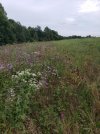Brian662
5 year old buck +
I have an 8 acre field that I began to enroll in CRP and I had in the plans to be a mixture of pollinators and NWSG blends. I've since had second thoughts about that after listening to Dr Harper talk about the benefits of cover (quickly growing) in a fallow ag field.
The field is a rectangle and drops in elevation from South to North (North facing) about 80-90 feet in elevation. It is pinched between two fence rows that are primarily mature box elders to the north and south. The east side is my property line and the neighbor has a 30 acre woodlot over there.
My goal is bedding cover and browse and I realize that my flexibility is greatly increased if I don't enroll in the CRP. At some point I may consider a long, linear food plot along the north fence row that snakes along to the south (along the west side).
My property has an abundance of food in relation to cover and I really need to increase cover as quickly as possible.
I took a 12 acre ag field out of rotation on the west side of my property last year and converted it to switchgrass with diversity pockets which should be great cover and habitat by next year. My pockets are filled with early successional growth and browse in under a year's time.
My question is, for those of you who have completed an ag field "restoration", what have you had success or failure doing? I'm contemplating starting the field off with a NWSG mixture and some additional forbs (similar to a CRP CP-25 mix) and then letting the early successional growth catch up and eventually over take it in the meantime I could mix shrub plantings and spruce plantings for bedding cover.
I could either do that, or let mother nature run its course and see what happens but also include some caged shrubs and spruce.
If the diversity pockets I have on the other side of my property are any indication, it'll be a box elder forest in no time, which I don't think is the worst thing.
I'm located in SE MN and have pretty heavy clay soil.
Thanks for any past experience or ideas you guys have. I'd be happy to add pictures of the field and property layout if you think it would be helpful.
Also, I'm aware that CRP pays better and would potentially be more diverse with pollinators, but I'm more interested in the best deer habitat/cover possible without necessarily being forced to maintain the successional growth at the mid term of a contract. As well as placing a food plot within the field eventually. If anyone has podcasts or YouTube stuff relevant to this that you'd like to share it would be much appreciated. Thanks!
The field is a rectangle and drops in elevation from South to North (North facing) about 80-90 feet in elevation. It is pinched between two fence rows that are primarily mature box elders to the north and south. The east side is my property line and the neighbor has a 30 acre woodlot over there.
My goal is bedding cover and browse and I realize that my flexibility is greatly increased if I don't enroll in the CRP. At some point I may consider a long, linear food plot along the north fence row that snakes along to the south (along the west side).
My property has an abundance of food in relation to cover and I really need to increase cover as quickly as possible.
I took a 12 acre ag field out of rotation on the west side of my property last year and converted it to switchgrass with diversity pockets which should be great cover and habitat by next year. My pockets are filled with early successional growth and browse in under a year's time.
My question is, for those of you who have completed an ag field "restoration", what have you had success or failure doing? I'm contemplating starting the field off with a NWSG mixture and some additional forbs (similar to a CRP CP-25 mix) and then letting the early successional growth catch up and eventually over take it in the meantime I could mix shrub plantings and spruce plantings for bedding cover.
I could either do that, or let mother nature run its course and see what happens but also include some caged shrubs and spruce.
If the diversity pockets I have on the other side of my property are any indication, it'll be a box elder forest in no time, which I don't think is the worst thing.
I'm located in SE MN and have pretty heavy clay soil.
Thanks for any past experience or ideas you guys have. I'd be happy to add pictures of the field and property layout if you think it would be helpful.
Also, I'm aware that CRP pays better and would potentially be more diverse with pollinators, but I'm more interested in the best deer habitat/cover possible without necessarily being forced to maintain the successional growth at the mid term of a contract. As well as placing a food plot within the field eventually. If anyone has podcasts or YouTube stuff relevant to this that you'd like to share it would be much appreciated. Thanks!

